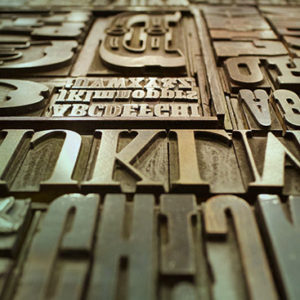Letterpress
 In letterpress printing, the face of image elements is in relief, i.e., it is raised above open areas. Historically, cast letters or types were set in a frame, inked and used in a hand-press for printing. Typesetting machines were introduced in the late 19thcentury. Photocomposition techniques arrived in the early 20th century. This led to the use of chemically etched metal plates for direct printing. However, for long runs or where multiple plates per page were required as in large newspapers, moulds were made from the original plate (pattern plate) and then the actual printing plates were cast, most commonly from lead. These lead plates, called stereotypes, weighed about 45 pounds each for a newspaper-size page.
In letterpress printing, the face of image elements is in relief, i.e., it is raised above open areas. Historically, cast letters or types were set in a frame, inked and used in a hand-press for printing. Typesetting machines were introduced in the late 19thcentury. Photocomposition techniques arrived in the early 20th century. This led to the use of chemically etched metal plates for direct printing. However, for long runs or where multiple plates per page were required as in large newspapers, moulds were made from the original plate (pattern plate) and then the actual printing plates were cast, most commonly from lead. These lead plates, called stereotypes, weighed about 45 pounds each for a newspaper-size page.
The introduction of personal computers in the sixties led many small printers to change to offset (lithographic) printing, but this was not economically feasible for publishers or medium- and large-size newspapers, who had a huge capital investment in letterpress equipment. Photopolymer plates made it possible for many newspapers to utilize modern photocomposition techniques using existing letterpress equipment. There was significant growth of photopolymer letterpress systems in the seventies. At the height of letterpress plates boom, over 40 million sq.ft. of photopolymer plates were used annually for newspaper printing in the US alone around the year 1980.
The first photopolymer-based letterpress plate is believed to be developed by Time Inc. and used by them in 1957 for magazine printing. This plate, called Tilon, was based on nylon chemistry. In 1960, DuPont came out with acrylic-based Dycril followed by Nyloprint by BASF in 1968. The last one is still in use for commercial printing including for dry offset which is also a letterpress printing except that an intermediate blanket cylinder transfers the image from a curved shallow-relief plate to the substrate. These plates were expensive for use in newspaper printing. In 1970, Asahi of Japan and W.R. Grace of U.S.A. introduced liquid photopolymers for newspapers. Nippon Paint of Japan developed a lower cost solid plate based on polyvinyl alcohol chemistry and was introduced in the US in 1973 as Napplate. The last one is still used by some newspapers today.
Currently, producers from Japan supply bulk of the letterpress photopolymer plates. For the names of suppliers see Printing Plates. They are used for printing of metal and plastic containers, narrow web printing and speciality/fine printing. Letterpress plates are also used as master plates or pattern plates, embossing plates and for making signs.
Copyright © 2007-2008 Savla Associates

